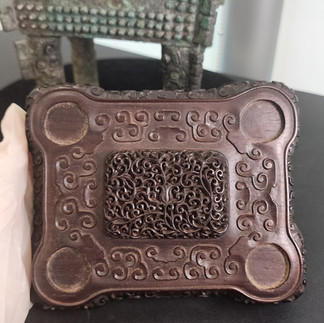

商末 父戊方鼎
The Fu Wu fangding,
Late Shang dynasty
Estimate
2,000,000 - 5,000,000 HKD
方鼎造型紋飾別出心裁,出戟、乳釘、獸面、冠鳥,大方不凡。同具「父戊」銘之方鼎僅有一例,現存上海博物館,原屬潘祖蔭(1830-90年)名藏,銘文早見著錄甚豐,收入陳佩芬,《上海博物館中國古代靑銅器》,倫敦,1995年,圖版23。近年商代墓葬考古研究發現如此飾紋華美之重要銅鼎,大多成對鑄造;例如安陽婦好墓出土一對尺寸較小之弧腹銅鼎,見《殷墟婦好墓》,北京,1980年,圖版11:3-4。本品與上博方鼎的銘文與飾紋均相匹配,大有可能與潘祖蔭舊藏方鼎原屬一對。
專場成交細節紀錄參考:



自古以來,鼎乃權力地位的象徵,在吉金禮器中至為重要,宗親權貴才配享用。商周銅鼎多採弧腹,方鼎則較罕。傳說鼎乃大禹所創,云他建立夏朝後鑄成九鼎以喻九州。雖無商代以前銅質方鼎的考古實證,但二里頭和二里崗均有出土陶質方鼎,可資參考。及至商周,在祭祖等儀典上,吉金方鼎已居中至正,僅限貴族要員尊享,重要性無庸置疑。
與此方鼎形飾相類之例極稀。比較安陽商邑出土二例,圖見《中國青銅器全集》,卷2,北京,1997年,圖版44、49,前例1990年郭家莊M160墓出土,後例乃1950年在該區採集所得,現貯河南新鄉市博物館。杜克舊藏也有一例,圖見陳夢家,《美帝國主義劫掠的我國殷周銅器集錄》,北京,1962年,編號A70,後售於紐約佳士得2004年9月21日,編號150。台北故宮尚有一「亞醜」方鼎,圖載《故宮商代青銅禮器圖錄》,台北,1998年,編號98及封面。


the ritual bronze food vessel of rectangular section with heavy flanges at the corners and supported on four cylindrical legs, each side intricately cast in high relief with a frieze of birds facing each other over a flange against a leiwen ground, below the frieze with a rectangular area decorated with a lozenge pattern, bordered on three sides by neatly arranged rows of protruding bosses, the legs cast with animal masks, each divided in half by flanges, the rim set with two upright loop handles and cast inside below the rim with two characters reading Fu Wu ('Father Wu'), zitan wood stand and Japanese double wood box, one of which with Zoroku Hata's inscription dated 1917
h. 22.2 cm
連 紫檀座及日本木盒,其一木盒帶秦蔵六丁巳年(1917年)題字

類似參考方鼎
哈佛大學藝術博物館
藏有一件類似的方鼎:1943.52.104: 'Fangding' Ritual Food Vessel with Abstract Decor

上海博物館
藏有一件西周“員”方鼎
员方鼎
年代: 西周早期
尺寸: 高22.7厘米,口横18.0厘米,口纵14.5厘米
来源: 孙鼎1979年捐赠
主题: 蛇、乳钉纹、雷纹、兽面纹
铭文 文字释文: 唯正(征)月既望癸酉,王狩(兽)于■,王令员执犬休。善用乍父甲?彝。



Catalogue Note
Only one other fangding of this striking design is known to bear the same ‘fu wu’ inscription. Preserved in the Shanghai Museum, this very similar piece was once in the famous bronze collection of Pan Zuyin (1830-90), illustrated in Chen Peifen, Ancient Chinese Bronzes in the Shanghai Museum, London, 1995, pl. 23, and its inscription widely recorded in early compendia. Recent excavations of Shang tombs show that ding vessels of this quality and importance were frequently produced in pairs; compare a pair of smaller rounded ding from the lavishly furnished tomb of Fu Hao at Anyang in Yinxu Fu Hao mu / Tomb of Lady Hao at Yinxu in Anyang, Beijing, 1980, pls 11:3 and 4. Given this, the shared inscription, and the similarity of decoration between the two pieces, it seems highly likely that the Pan Zuyin fangding in the Shanghai Museum was once a companion to the present lot.
Revered as symbols of great power and status since antiquity, ding vessels are considered to be the most ritually significant of bronze ceremonial vessels and commonly associated with kingship and high rank. While the vast majority of Shang and Zhou dynasty ding were produced with rounded bodies, those of rectangular form with four legs (fangding) are comparatively rare. According to legend, the first nine ding were cast by Yu the Great, founder of the Xia dynasty, and although archaeological evidence has yet to reveal bronze fangding from before the Shang dynasty, pottery versions from the Erlitou and Erligang periods do survive. By the Shang and Zhou dynasties, bronze fangding became central features of ancestral worship and other sacrificial ceremonies, and their ownership appears to have been restricted to only the most distinguished members of the nobility.
A very small number of other known fangding share this rare form and design. Compare two very similar pieces excavated from the Shang capital in Anyang, illustrated in Zhongguo qingtongqi quanji [Complete series on Chinese bronzes], vol. 2, Beijing, 1997, pls 44 and 49: the former excavated from tomb M160 in Guojiazhuang in 1990; the latter uncovered from the area in 1950, now preserved in the Xinxiang Museum, Henan; a third, from the Duke Collection, was illustrated in Chen Mengjia’s seminal work on Chinese bronzes in American collections, Meidiguozhuyi jielue de woguo Yin Zhou tongqi jilu [Compilation of Yin and Zhou archaic bronzes in America], Beijing, 1962, no. A70, and later sold at Christie’s New York, 21st September 2004, lot 150; and a fourth, with a ‘ya chou’ inscription, is preserved in the Palace Museum, Taipei, illustrated in Shang Ritual Bronzes in the Palace Museum Collection, Taipei, 1998, cat. no. 98 and cover.

Mineo Hata FAQ
1. Who is Mineo Hata and what is he known for?
Mineo Hata is a renowned Japanese art dealer with a deep appreciation for Chinese art, particularly pieces from the early Ming Dynasty. He is known for his discerning eye and his collection of rare and exquisite objects. Hata operates a charming gallery in Osaka's antique district, Oimatsu-cho, filled with a variety of antiquities. He is also known for his discreet dealings in Japanese dealer's auctions, a closed market where some of the finest objects are sold.
2. What is the significance of the early Ming Dynasty in Chinese art history?
The early Ming Dynasty, specifically the Yongle and Xuande reigns, marked a period of artistic flourishing fueled by imperial patronage. This era witnessed the creation of masterpieces characterized by vitality, strength, and exquisite craftsmanship, particularly in porcelain, lacquerware, and sculpture. The artistic standards set during this period continued to influence Chinese art for centuries.
3. What are some of the notable pieces that Mineo Hata has handled?
Mineo Hata has handled an array of impressive pieces, including:
A magnificent blue and white ewer from the Yongle period, decorated with a rare scrolling lotus design and ruyi-shaped cartouches. It was once owned by Konosuke Matsushita, the founder of Panasonic.
An exceptional pair of massive marble Fu lions, late Ming dynasty, originally serving as protective door guardians.
A superb cinnabar lacquer box of unusually large size, decorated with elaborate lotus blooms. A similar box resides in the Taipei Palace Museum's collection.
A fine and rare blue and white "fruit" meiping vase, Yongle period, notable for its delicate potting, smooth glaze, and the lush fruit pattern that became a standard for centuries.
A sensational blue and white bowl from the Xuande period, masterfully painted with fishes swimming among lotus flowers and water weeds. This bowl set a world record for blue and white porcelain at auction.
A monumental limestone head of Vairocana Buddha, Tang dynasty, exceptional for its size and the quality of its carving.
4. What is a Fu Wu Fangding and what is its significance?
A Fu Wu Fangding is a type of ancient Chinese bronze ritual food vessel. The term "fangding" refers to its rectangular shape with four legs, a relatively rare form compared to the more common rounded ding vessels. The specific Fu Wu Fangding in Mineo Hata's collection is highly significant because:
It bears the inscription "Fu Wu" ("Father Wu").
It is believed to be a pair with a similar fangding housed in the Shanghai Museum, once part of the renowned Pan Zuyin collection.
Fangding vessels represent power and high status, primarily used by nobility during the Shang and Zhou Dynasties for ancestral worship and sacrificial ceremonies.
5. What is the connection between the Fu Wu Fangding and the Harvard University Art Museum?
The Harvard University Art Museum possesses a similar Fangding, though it features an abstract decor rather than the intricate bird frieze found on the Fu Wu Fangding. However, both vessels exemplify the importance of these bronzes as ritual objects and historical artifacts. The Harvard Fangding's inscription highlights the early use of writing in China, often denoting the vessel's owner or dedicated ancestor.
6. What makes the Fu Wu Fangding so valuable?
The Fu Wu Fangding holds immense value due to several factors:
Rarity: Fangding vessels with this specific rectangular shape and four legs are uncommon.
Inscription: The "Fu Wu" inscription connects it to a known historical figure or lineage.
Pair: Its probable pairing with the Shanghai Museum's fangding elevates its historical significance and market value.
Condition: The detailed description suggests the piece is in excellent condition, which further contributes to its value.
7. Where can I see some of the pieces handled by Mineo Hata?
While Mineo Hata's private collection remains largely unseen, several pieces he handled have been auctioned through prominent houses like Sotheby's Hong Kong and are now housed in museums and private collections worldwide. You can research the auction records and current locations of pieces like the blue and white ewer, the marble Fu lions, or the cinnabar lacquer box through online databases and auction house archives.
8. What is Mineo Hata's legacy in the world of Asian art?
Mineo Hata's legacy is built on his deep understanding and appreciation of Chinese art. His decades of experience in the Japanese art market, combined with his sharp eye for quality and rarity, have allowed him to bring to light some of the most significant pieces from the early Ming Dynasty. His contributions extend beyond collecting; he has facilitated the appreciation and understanding of this important period in Chinese art history by making these treasures available to museums, institutions, and collectors globally.
秦峰男 / Hata
二十年前在大阪古董街區老松町,是我人生中第一次遇見秦峰男。當時,在他別緻的藝廊內,擺滿了佛教殘像、古代瓷器和各色各樣的骨董,而我和他則坐在一樓的茶室,身旁是他全部家人,我們喝茶品茗,如此便開展了一段在過去二十年讓我津津樂道的交情。除了雅器珍品之外,秦先生對於展示傑作收藏同樣不乏意興,這份博物識珍的能力讓他保持敏銳眼光,好奇而不流於俗。
不久,我和同事瀬谷瑞香獲邀到神戶附近古色古香的蘆屋市,在秦峰男家中作客,他和幾位兒子多年來便是在家中檐廊的和煦日光下,讓我們鑑賞一件又一件的中國藝術瑰寶。這些藏品多半 是十五世紀初宮廷藝術上乘佳作,極其珍罕。至今,明初依然被認為是藝術發展上輝煌盛世之一,王朝的崛起為藝作貫注源源的生命力,在皇室的大力支持下,豐碩結晶。
2010年,有一次我們拜訪蘆屋時,秦峰男向我們展示一件精緻典雅的明代永樂青花執壺,壺身兩面飾以如意開光串枝蓮紋,設計難得一見。此青花壺乃工業家兼松下電器創辦人松下幸之助舊藏,他當時是透過著名古董老字號繭山龍泉堂購入的。
現存已知的類例寥寥無幾,包括伊斯坦堡托普卡比宮殿鄂圖曼帝國蘇丹藏品,以及德黑蘭阿德比爾聖殿薩法菲國王舊藏兩件。先生隨後帶我們參觀所居,走到他的室外停車坪,一對略顯違和卻極為莊嚴的宮廷大理石獅子巍然矗立。獅子代表著力量和安全,也象徵了王朝的權力,置於門前,鎮守家宅,在形上和形下的世界提供保護。
一年後,我們又有幸在秦宅看到一個尺寸 碩大的明初剔紅漆盒,蓋上滿雕蓮花綻放,精細入微,繁茂瓣葉融入輕柔 如絹、溫潤含蓄的漆紅光澤中。永宣年間,漆盒乃最受歡迎的宮廷雕漆品類之一,但大多數已知存世例子尺寸較小,與此盒尺寸紋飾均相似者,僅止一例,現為 台北故宮典藏。
日本古董商的拍賣一直不對外開放,在這個密不透風的保密平台上,偶有珍罕至極之品。我同事瀬谷瑞香總是會密切留意風聲,因此,2014年初當一件青花梅瓶以相當於200萬美元成交時,她很快便告訴我有關秦峰男成功投得梅瓶的傳言。幾天後,我便在蘆屋的小檐廊上, 欣賞著我見過保存最佳、畫工最妙的瑞果紋梅瓶,其優美線條和細膩釉面都叫人讚嘆不已。此式梅瓶造型勻稱、果紋豐碩,自成典範,啟發往後數百年的藝匠巧思。
至於我手上接觸過最讓人著迷的明代青花瓷器,依然是這件雅緻細膩的青花盌,其鈷青發色絢麗,妙寫魚兒荷塘暢游,水草翩翩起伏,菱花盌形巧妙地讓人產生錯覺,看來仿若在水底輕柔擺動。鈷藍青料的運用出神入化,無與倫比,深淺發色的層次豐富,荷葉上有留白的葉脈紋理,在荷葉沿邊更見黑疵點綴, 栩栩如生。自1960年代初以來,此盌在日本名聞遐邇,曾經成為許多著名刊物和展覽的主角,最後落入秦峰男的手中。2017 年此盌在蘇富比上拍,經過連番激烈競價 後,以打破青花瓷器世界紀錄的價格成交。
自二十世紀初以來,早期佛教造像在日本 一直備受青睞。2023年蘇富比慶祝踏足亞洲五十年之際,秦先生委託我們獻呈一尊石灰岩雕寶冠佛首,尺寸碩大,工藝超卓,展現大唐武后當政期間,國都長安(現陝西西安)獨特的朝廷雕刻風格。河南省龍門石窟擂鼓台南洞有一圓雕近例,約造於公元700年。雕像佛相風格獨特,卻與蘇富比過去十年拍賣過的兩尊夾紵乾漆佛首臉容有類同之處,眉若刀裁,五觀皆以銳利凹槽框之,強調佛容氣勢。
適逢蘇富比於中環置地遮打舉行首季拍賣,我們很榮幸獲秦峰男先生委託,呈獻他數十年來集美聚珍之果,包括早期瓷器、造像、青銅和漆器。其中包括一件極為罕見、甚至獨一無二的中國漆藝傑作。 黑漆嵌螺鈿蓋盒尺寸碩大,上綴魚龍逐珠,環飾水波瀲灧,窮妙極巧。龍紋乃至纏枝花卉皆體現了南宋時期的高雅韻致。
是次精彩拍賣把秦峰男的敏銳眼光及其品藝人生娓娓道來,相信必然讓一眾藝文雅士藏家欣喜期待。
仇國仕 蘇富比亞洲區主席 亞洲藝術部主席兼環球主管
Mineo Hata Collection FAQ
What is significant about the Mineo Hata Collection being offered at Sotheby's?
The Mineo Hata Collection is significant for several reasons. First, it represents decades of careful acquisitions by a discerning collector, Mineo Hata. Second, the collection spans various categories of Chinese art, including early ceramics, sculptures, bronzes, and lacquerware. Lastly, it contains several museum-quality pieces, some of which are exceptionally rare or even unique.
What is an example of a rare Ming Dynasty piece in the collection?
One standout piece is a blue and white ewer from the Yongle period, adorned with a rare design of scrolling lotus framed by ruyi-shaped cartouches. This ewer was previously owned by Konosuke Matsushita, the founder of Panasonic, and has only a few known counterparts, including one at the Topkapi Palace in Istanbul and two at the Ardebil Shrine in Tehran.
What is notable about the Ming Dynasty blue and white meiping acquired by Mineo Hata?
The blue and white meiping, acquired at a Japanese dealer's auction in 2014, is considered one of the most pristine and well-painted examples of its kind. Its delicate potting, smooth glaze, and lush fruit pattern set a standard that influenced ceramic artistry for centuries.
What makes the blue and white bowl from the Mineo Hata Collection so exceptional?
The blue and white bowl stands out for its masterful painting depicting fish swimming among lotus flowers and water weeds. The dynamic composition and skillful use of cobalt blue create a mesmerizing illusion of underwater movement. This bowl broke a world record for blue and white porcelain at a Sotheby's auction in 2017.
What is the historical significance of the pair of imperial marble Fu lions in the Mineo Hata Collection?
The pair of Fu lions represents strength, security, and the power of the empire. These majestic creatures were typically placed at main gates as guardians to provide protection in both the spiritual and physical realms.
What is unique about the cinnabar lacquer box in the collection?
The cinnabar lacquer box is notable for its unusually large size and elaborate decoration of lotus blooms rendered in meticulous detail. While boxes were popular items produced for the imperial court during the Yongle and Xuande reigns, most surviving examples are much smaller. A similarly sized and decorated box is found only in the collection of the Taipei Palace Museum.
What can be said about the stone head of Vairocana Buddha from the collection?
The monumental stone head of Vairocana Buddha is exceptional for both its size and the magnificent quality of its carving. It exemplifies the Tang metropolitan style prevalent in the capital Chang’an during Empress Wu’s reign. This style is characterized by sharp, well-defined features, and a similar example can be found in the Longmen cave temples in Henan province.
What is the most unique piece in the Mineo Hata Collection being offered at Sotheby's?
Perhaps the most unique piece in the collection is a large circular box showcasing the intricate art of Chinese lacquer. Inlaid with iridescent nacre against a black lacquer background, the box features a striking dragon design amidst a border of stylized waves. The dragon and flower scroll motifs embody the refined aesthetic of the Southern Song Dynasty, making this piece an exceedingly rare, if not unique, masterpiece.
Timeline of Events
Sui Dynasty (581-618)
Undated: A white porcelain tripod dish with three ring feet is created and buried in tomb YM243 in Xiaotun Village, Anyang, Henan province. This dish represents the first phase of white porcelain production.
Sui - Early Tang Dynasty (Late 6th - Early 7th Century)
Undated: A set of five white porcelain cups and a matching tripod dish with three ring feet are created. This set eventually becomes part of the Harvard Art Museums collection.
Early Tang Dynasty (618-907)
Undated: Production of tripod dishes with three ring feet continues, influencing the development of similar three-colour wares in the Tang dynasty.
Late 20th - Early 21st Century
Approximately 20 years ago: Nicolas Chow meets Mineo Hata for the first time in Hata's gallery in Osaka.
Undated: Chow and his colleague Mizuka Seya are invited to Hata's home in Ashiya, where they are shown numerous Chinese art treasures over several visits.
2010
Undated: Hata shows Chow and Seya a Ming dynasty Yongle period blue and white ewer previously owned by Konosuke Matsushita.
Undated: Hata also shows them a pair of imperial marble Fu lions located in his outdoor parking area.
2011
Undated: Hata shows Chow and Seya a large cinnabar lacquer box from the Yongle and Xuande reigns, similar to one in the Taipei Palace Museum.
2014
Early 2014: Hata purchases a Ming dynasty blue and white meiping at a Japanese dealers' auction for US$2 million.
Undated: Chow views the meiping at Hata's home in Ashiya.
2017
Undated: A Ming dynasty blue and white bowl from Hata's collection, depicting fish swimming among lotus flowers, is sold at Sotheby's, breaking the world record for blue and white porcelain.
2023
Undated: Hata consigns a monumental stone head of Vairocana Buddha from the Tang dynasty to Sotheby's for auction.
Undated: Hata also consigns a large circular black lacquer box inlaid with mother-of-pearl from the Southern Song dynasty, along with other pieces from his collection, to Sotheby's for auction.
Cast of Characters
Mineo Hata (秦峰男)
Bio: A prominent Japanese art collector and dealer with a keen eye for Chinese art, particularly from the Ming dynasty. He has a long-standing relationship with Nicolas Chow and Sotheby's.
Nicolas Chow (仇國仕)
Bio: Chairman of Asia and Worldwide Head of Asian Art at Sotheby's. He has known Mineo Hata for over 20 years and has been privy to many of Hata's remarkable Chinese art discoveries.
Mizuka Seya (瀬谷瑞香)
Bio: Colleague of Nicolas Chow at Sotheby's. She closely follows the Japanese art market and alerted Chow to Hata's acquisition of the blue and white meiping.
Konosuke Matsushita (松下幸之助)
Bio: Industrialist and founder of Panasonic. He was a previous owner of the Ming dynasty Yongle period blue and white ewer now in Hata's collection.
Walter C. Sedgwick Foundation
Bio: A foundation that owned the set of five white porcelain cups and matching tripod dish before donating it to the Harvard Art Museums in 2006.
Other Mentions:
Tokiwayama Bunko: An institution referenced for its expertise on early white porcelain.
Oxford Authentication Ltd: A company that conducted thermoluminescence testing on the Sui-Early Tang dynasty white porcelain tripod dish.
Regina Krahl: Author of "Chinese Ceramics From The Meiyintang Collection," which features a similar tripod dish to the one auctioned by Sotheby's.
Mayuyama & Co.: A celebrated Japanese art dealership through which Konosuke Matsushita acquired the Ming dynasty Yongle period blue and white ewer.
Taipei Palace Museum: Houses a cinnabar lacquer box similar in size and design to the one owned by Hata.
Empress Wu: A powerful ruler of the Tang dynasty during which the monumental stone head of Vairocana Buddha was created.

























Commentaires